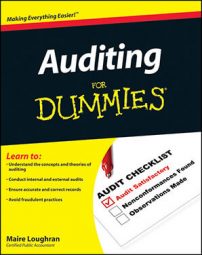To perform an audit, you have to know how your client handles inventory. Knowledge about different inventory systems helps you to plan and execute an effective and efficient audit. Two major types of inventory systems exist: periodic and perpetual. Usually, if a retail business uses electronic cash registers (ECRs) to read the product bar codes, it uses the perpetual method.
Periodic inventory systems
Under the periodic system, a company takes the physical inventory periodically and uses the resulting figure to adjust the balance sheet inventory asset account. Retail shops that use periodic inventory usually take inventory at their particular year-end. However, a business could take inventory more often, such as quarterly or at the end of every heavy sales season (like Valentine’s Day, Mother’s Day, and the December holidays).
Next, the company’s accounting department subtracts ending inventory totals from the beginning inventory after adding in all inventory purchases made during the period. The resulting number is cost of goods sold (COGS). The balance sheet inventory account is reduced, and the income statement expense account COGS is increased by that number to match revenue with expenses.
Perpetual inventory systems
The other inventory system used is the perpetual system. With this system, the inventory count is updated constantly, perpetually, as the electronic cash registers (ECRs) record sold items. Most large retailers have ECRs. If you’ve ever used the self-checkout, you’ve used one. The checkout features a glass window with a red beam of light. You run the bar code of a product over the red beam, and the price (updated for sales if necessary) is automatically recorded as a sale for which you’re charged and the business receives revenue.
This system takes the cost of the sold item out of the asset inventory account and moves it to cost of goods sold. With point-of-sale inventory, cash register transactions update all purchase, inventory, COGS, and sales information throughout the system in real time as the transactions occur. For example, when you go into Target and buy a cookware set as you are checking out, the point-of-sale software updates the kitchen department records to show that one less cookware set is available for sale. The software also updates COGS to show the set’s cost, and it updates revenue to reflect the set’s retail price.
Most large retail stores have point-of-sale inventory systems with item restock and reorder level alerts. The restock level alert advises purchasing employees when sales cause the number of an item in inventory to drop below the company’s minimum quantity requirement. If the company also programs the reorder level (the maximum quantity of each item it wants to maintain on hand), the software can tell purchasing exactly how many of the item should be ordered.
Even if a client uses a point-of-sale system, taking a physical inventory at year-end is still important to verify that the perpetual system is working correctly. Taking a physical inventory is also the best way to identify breakage and employee theft issues.

